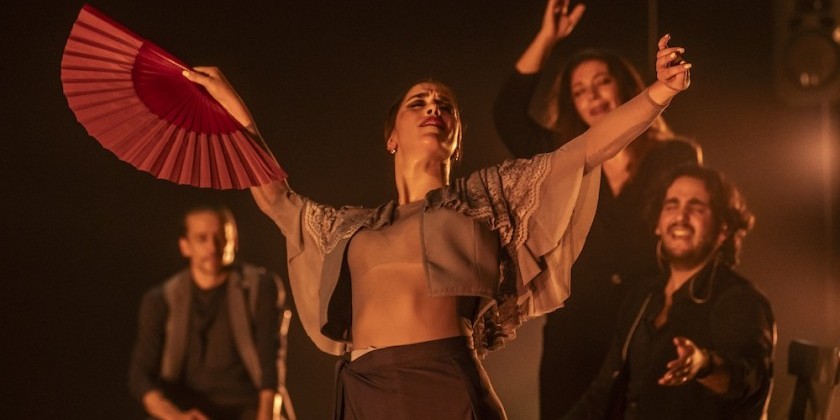IMPRESSIONS OF: "Crawl: Chapter 4"

At the Brooklyn Desks Warehouse in Bushwick
Emerging from the L Train onto Morgan Street at night can feel like being dumped inside a warehouse graveyard. While some structures radiate vibrations of commercial or residential occupancy, others feel cold and abandoned. Sporadic construction sites sit behind broken fences, and graffiti murals rest on the side of dilapidated buildings strategically hiding signs of neighborhood wear and tear.
On September 26th, CRAWL: Chapter 4, the last in a series of multi-disciplinary, nomadic arts projects, occupied one of these warehouses in Bushwick, Brooklyn. The sounds of Ike and Tina Turner’s "Proud Mary" enveloped our bodies at the doorway and soaked into every corner of the space. It felt like a dance club—a fascinating departure from the normal performance experience.
The space was open, industrial, and unfinished. Electrical wires connecting to yellow light bulbs hung above our heads. Iridescent light sources on the floor bounced shadows off cement walls. A crimson Hyundai Santa Fe occupied a corner near the entrance and people peppered the space, sipping drinks, chatting with friends, and greeting family.

Dante Brown’s Soapbox (LP) began without cue or announcement as seven dancers materialized within the empty space and a lone dancer swept around the Santa Fe. The SUV’s headlights illuminated her energetic phrase work. Punches, jumps, and jabs circled around elongated attitude turns. The soloist took breaks to melt onto the hood of the SUV while disrupted dust particles danced alongside her into the pathway of the headlights. The remaining dancers advanced slowly toward her like an amorphous amoeba. Soon the audience joined the dancers to frame the space around the Santa Fe and the boundaries of the active space fluctuated. Piling into the SUV the dancers cranked it up and, beckoning the audience in its wake, the car and riders made a slow procession to a larger spot in the warehouse.
Soapbox (LP) presented a collage of ideas accompanied by a pop and R&B soundscape. Fragmented scenes shifted from race and politics to lip-syncing antics without offering a through line connecting one scene to the next. When the dust settled, the remnants of images left us feeling scattered.
E.Oks, with help from a collaborator and 4-piece band, christened the space with spoken word in Play Pretend. His presence remained confident and cool as he used responses from questions posed at the beginning of the evening (“What is one question you pretend to have answered, and one thing you pretend to be?”) to guide his freestyle. Clever one-liners were designed to engage the audience, but unfortunately the warehouse acoustics made it difficult to sustain our undivided attention.

Gregory Dolbashian’s Dashow rounded out the evening featuring indulgent gestures that stretched like taffy, as well as fast, syncopated movements which accentuated his dancers’ physicality and precision. Flowing in and out of solo, group and partner work, the dancers periodically abandoned their tasks to stride into new movement territory. Dolbashian’s voice laced through a musical soundscape. He discussed being a heterosexual man in the dance world and the difficulties of occupying certain spaces that generated feelings of uncertainty and vulnerability around his own sexuality. His narrative felt disembodied, like a foreign entity wedging itself around the quartet.

During a pre-show discussion, co-moderated by Cecilia Lynn-Jacobs and choreographer and educator Sydnie Mosley, the artists chatted about privilege and systematic oppression. They wondered how to make space for people from different backgrounds and considered the spectrum of work people can access. Dashow seemed to circumvent these considerations by situating the story of a white male on top of a minority cast. As Dolbashian shared his struggles of being a straight man, I was drawn to the contrast between him and the individuals he chose to work with. Dolbashian, a white male, picked two black males and two white females to present his work. Perhaps this choreographic choice was intended to demonstrate clear evidence of privilege by offering a visual representation that suggested how majority narratives are often placed on top of minority bodies. Perhaps this was an oversight. With each anecdote, the dancers’ experience became increasingly more silent and I wondered how Dolbashian viewed his story in relationship to others. The incongruity of the audio and visuals made it difficult to consider much else.
CRAWL: Chapter 4 provided an opportunity to experience performance in a delightfully, non-passive way. We were reminded that dance is a voluminous, three-dimensional entity, and even if we only experience this art form from one side, there is always potential to expand the possibilities 360 degrees.
Learn more about CRAWL and participating artists at www.jointhecrawl.com.
Share Your Audience Review. Your Words Are Valuable to Dance.
Are you going to see this show, or have you seen it? Share "your" review here on The Dance Enthusiast. Your words are valuable. They help artists, educate audiences, and support the dance field in general. There is no need to be a professional critic. Just click through to our Audience Review Section and you will have the option to write free-form, or answer our helpful Enthusiast Review Questionnaire, or if you feel creative, even write a haiku review. So join the conversation.















